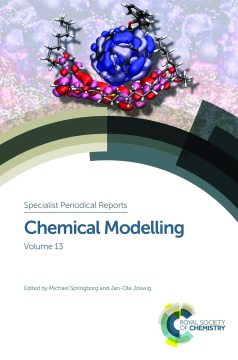
Additional Information
Book Details
Abstract
Chemical modelling covers a wide range of disciplines and with the increase in volume, velocity and variety of information, researchers can find it difficult to keep up to date with the literature in this field. This book is the first stop for any materials scientist, biochemist, chemist or molecular physicist wishing to acquaint themselves with major developments in the applications and theory of chemical modelling. Containing both comprehensive and critical reviews, its coverage includes materials for energy storage, nanoflakes, chemical modelling of fluidics near surfaces and organic solar cells.
Table of Contents
| Section Title | Page | Action | Price |
|---|---|---|---|
| Cover | Cover | ||
| Contents | vii | ||
| Preface | v | ||
| Organic solar cells | 1 | ||
| 1 Introduction | 1 | ||
| 2 Morphology | 3 | ||
| 3 Transport through Marcus equation: kinetic Monte Carlo | 5 | ||
| 4 CT state splitting diagram | 13 | ||
| 5 Conclusions and perspectives | 23 | ||
| Acknowledgments | 24 | ||
| References | 24 | ||
| Exploring the electronic structure of nanohybrid\r\n materials for their application in solar cell | 27 | ||
| 1 Introduction | 27 | ||
| 2 Experimental studies, a brief review | 29 | ||
| 3 Theoretical studies, tuning of energy band alignment | 32 | ||
| 4 Conclusions and future perspectives | 64 | ||
| Acknowledgments | 66 | ||
| References | 66 | ||
| Chemical modelling of fluids near surfaces | 72 | ||
| 1 Introduction | 72 | ||
| 2 Classification of fluid behaviour near surfaces | 74 | ||
| 3 Molecular simulation methodologies | 77 | ||
| 4 Prewetting transitions | 84 | ||
| 5 Wetting transition of water on solid surfaces | 89 | ||
| 6 Wetting transition of water on soft surfaces | 92 | ||
| 7 Conclusion | 100 | ||
| Acknowledgments | 100 | ||
| References | 100 | ||
| Theoretical studies of neutral and charged water clusters | 105 | ||
| 1 Introduction | 105 | ||
| 2 Neutral water clusters | 105 | ||
| 3 Anionic water clusters | 117 | ||
| 4 Protonated water clusters | 122 | ||
| 5 Conclusions | 125 | ||
| Acknowledgments | 126 | ||
| References | 126 | ||
| The incremental method – theory and applications \r\nin chemistry and physics | 132 | ||
| 1 Introduction | 132 | ||
| 2 General formalism | 133 | ||
| 3 Incremental methods for molecules | 143 | ||
| 4 Incremental methods for periodic systems | 164 | ||
| 5 Conclusions | 183 | ||
| Acknowledgments | 184 | ||
| References | 185 | ||
| Double hybrid density functional approximations | 191 | ||
| 1 Introduction | 191 | ||
| 2 Theoretical background and variants of double hybrid density functional approximations | 194 | ||
| 3 Extensions of the DHDFA approach | 204 | ||
| 4 Important technical improvements to extend the applicability of DHDFAs | 212 | ||
| 5 Outlook and conclusion | 215 | ||
| Abbreviations | 215 | ||
| References | 216 | ||
| DFT calculations of atoms and molecules in Cartesian grids | 221 | ||
| 1 Introduction | 221 | ||
| 2 The methodology | 225 | ||
| 3 Results and discussion | 244 | ||
| 4 Future and outlook | 253 | ||
| Acknowledgments | 254 | ||
| References | 254 | ||
| Molecular-level visualisation for educational purposes | 261 | ||
| 1 Introduction | 261 | ||
| 2 The scientific challenge of modelling the molecular level | 265 | ||
| 3 The pedagogical challenge of modelling the molecular level | 276 | ||
| 4 Conclusion | 280 | ||
| References | 281 |
